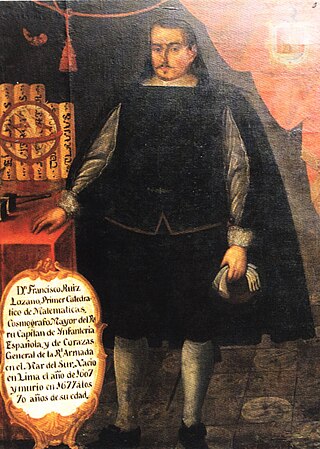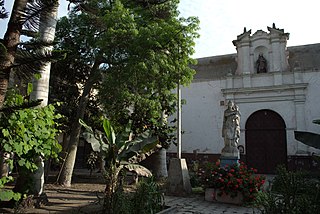
The Viceroyalty of Peru, officially known as the Kingdom of Peru, was a Spanish imperial provincial administrative district, created in 1542, that originally contained modern-day Peru and most of the Spanish Empire in South America, governed from the capital of Lima. Peru was one of the two Spanish viceroyalties in the Americas from the sixteenth to the eighteenth centuries.

, Capilla del Milagro and the Basilica of San Francisco.]]

The Palacio de Torre Tagle is a building built during the colonial era of Peru that currently serves as the main headquarters of the Ministry of Foreign Affairs of Peru. It is located in the Jirón Ucayali in the historic center of Lima, two blocks southeast of the Plaza Mayor de Lima.
The Rímac River is located in western Peru and is the most important source of potable water for the Lima and Callao Metropolitan Area. It belongs to the Pacific Slope, into which it flows after bathing the cities of Lima and Callao, together with the Chillón River, to the north, and the Lurín River, to the south. It is 204 km long and has a basin of 3,312 km², of which 2,237.2 km² is a humid basin. The basin has a total of 191 lagoons, of which only 89 have been studied. The river begins in the highlands of the Huarochirí Province in the Lima Region and its mouth is located in Callao, near Jorge Chávez International Airport.

Located principally in the city centre or Cercado de Lima and Rímac areas, the Historic Centre of Lima is among the most important tourist destinations in Peru.

Francisco de Villagra Velázquez was a Spanish conquistador, and three times governor of Chile.

Francisco Ruiz Lozano was a Peruvian soldier, astronomer, mathematician and educator.

Presbyter Matías Maestro Cemetery, formerly the General Cemetery of Lima, is a cemetery, museum and historical monument located in the Barrios Altos neighbourhood of Lima District, in Lima, Peru. Inaugurated on May 31, 1808, it was the first pantheon in the city since burials were previously held in the city's churches. It was named in honour of its designer, Spanish priest Matías Maestro.

Francisco de Aguirre was a Spanish conquistador who participated in the conquest of Peru, Bolivia, Chile and Argentina.

Cristóbal de Aguilar was a Peruvian painter. He specialized in portraying members of Lima's nobility and the political elite of the Viceroyalty of Peru.
Rosa Juliana Sánchez de Tagle y Hidalgo, Marquesa of Torre Tagle was a Peruvian aristocrat who descended from an important and influential Spanish aristocratic family which included the Marquis of Altamira. She also a shares the same ancestor as her husband the Marquis of Torre Tagle, as they both descended from the ancient line of Tagle founded in the Kingdom of Asturias.

Carlos Alberto Alcántara Vilar is a Peruvian stand-up comedian and actor.
Diego de Aliaga Sotomayor y Santa Cruz was a Peruvian politician and aristocrat who served as the first Vice President of Peru, from 1823 to 1824, under the presidency of José Bernardo de Tagle y Portocarrero, Marquis of Torre Tagle, appointed by the Peruvian Congress.

Vacunagate refers to a scandal in Peru over the secret COVID-19 vaccination of 487 people, mainly senior officials of the Executive Power of Peru. The crisis began on February 10, 2021, with the revelation that in October 2020 a coronavirus vaccine intended for Phase III of the Sinopharm clinical trials was secretly given to then-President Martín Vizcarra.

The Embassy of the United States in Lima is the official diplomatic mission of the U.S. to the Republic of Peru.

José Gregorio Castro Miranda, O.F.M., was a Roman Catholic prelate who was Bishop of Cuzco from 1910 to 1917. He mainly worked to integrate the local indigenous population to the church's teachings by translating prayers and church music to Quechua.

The Royal Hospital of Saint Andrew, originally known as the Hospital of Our Lady of the Conception, was a hospital in the neighbourhood of Barrios Altos, part of the historic centre of Lima, Peru.















